#Commercial Vehicle Group
Text
In before I start seeing people bitching about rainbow capitalism MY favorite rainbow capitalism story is about Subaru. Yes the Japanese car company.
In the nineties, they were struggling. They were competing with a dozen other companies targeting the main demographic at the time: white men ages 18-35, especially after a failed luxury car launch with a new ad agency. “What we need is to focus on niche demographics,” they decided, and then focused on people who enjoyed the outdoors. The Subaru was excellent at driving on dirt roads that many other vehicles couldn’t at the time, so it was perfect for all those off-road campers; they started making all-wheel drive standard in all their cars to help with that. And the people who wanted cars to go do outdoor stuff? Lesbians.
Okay. Of course it wasn’t only lesbians buying Subarus. They’re on the list with educators, health-care professionals, and IT people. But the point is, this Japanese car company interviewed this strange demographic (single, female head of household) and realized one important factor: They were lesbians. They liked to be able to use the cars to go do outdoorsy stuff, and they liked that they could use the cars to haul stuff rather than a big truck or van. Subaru had a choice to make then. They had four other demographics they could market to, after all--the educators, the health-care professionals, IT professionals, and straight outdoorsy couples. Their company didn’t hinge on this one “problematic” demographic.
And they decided “fuck it,” and marketed to lesbians anyway. This included offering benefits to American gay and lesbian employees for their domestic partners, so it didn’t look like a cash grab. (This was not a problem. They already offered those in Canada.)
Yes, there was some backlash. They got letters from a grassroots group accusing them of promoting homosexuality, and every letter said they’d no longer be buying from Subaru. “You didn’t buy from us before, either,” Subaru realized, and ignored them. It helped that the team really cared about the plan, and that they had many straight allies to back them up. There was also some initial backlash when Subaru hired women to play a lesbian couple in the commercial, but they quickly found that lesbians preferred more subtlety; “XENA LVR” on a license plate, or bumper stickers with the names of popular LGBTQ+ destinations, or taglines of “Get out. Stay out.” that could be used for the outdoors--or the closet.
Subaru said “We see you. We support you.” They sponsored Pride parades and partnered with Rainbow Card and hired Martina Navratilova as spokeswoman. They put their money where their mouth is and went into it whole hog. In a time where companies did not want to take our money, Subaru said, “Why not? They’re people who drive.” And that was groundbreaking.
49K notes
·
View notes
Text

#The cost to fuel electric vehicles in the United States is higher than gas-powered cars for the first time in 18 months#a consulting company said.#“In Q4 2022#typical mid-priced ICE (Internal Combustion Engine) car drivers paid about $11.29 to fuel their vehicles for 100 miles of driving. That cos#and over $3 less than the cost borne by comparable EV drivers charging commercially#” Anderson Economic Group (AEG) said in an analysis.
0 notes
Text
Helm.ai Raises $31 Million in Series C Funding Round for Autonomous Vehicle Softwar
Helm.ai Raises $31 Million in Series C Funding Round for Autonomous Vehicle Softwar
Helm.ai is a startup based in Menlo Park, California that is developing software for advanced driver assistance systems, autonomous driving, and robotics. The company recently raised $31 million in a Series C round, led by Freeman Group, pushing its valuation to $431 million.
The company has developed software that can understand sensor data as well as a human, using an unsupervised learning…

View On WordPress
#ACVC Partners#advanced driver assistance systems#Amplo#autonomous driving#autonomous vehicles#commercial partnerships#Freeman Group#funding#Goodyear Ventures#Helm.ai#Honda Motor Co.#neural networks#OEMs#R&D#Series C#software#Sungwoo Hitech#Tier 1 suppliers#unsupervised learning#valuation
1 note
·
View note
Text
#commercial vehicle group inc.#commercial vehicle sales#commercial vehicle insurance#commercial vehicle manufacturing
0 notes
Text
Hydrogen-powered trucks are expected to reach life-cycle cost parity with their fossil-fuel-burning peers in China by 2027 even without the aid of subsidies, a milestone which the world’s biggest producer and consumer of the zero-emission energy source, seeks to achieve eight years ahead of Europe.
This will push forward the country’s ambition to dominate the market for hydrogen fuel cells in the transport sector as Beijing’s enabling environment starts paying off, an industry executive said.[...]
“China has developed a world-leading industry in commercial vehicle applications for hydrogen fuel cell technology, with enterprises ranging from upstream raw materials to downstream products over the past decade,” said Robin Lin, chairman and president of Refire Group, a Chinese supplier of hydrogen fuel cell technologies.[...]
China has stepped up its game this year with the central and local authorities releasing a variety of hydrogen-related policies and incentives, following the release of its first national-level guidelines for the hydrogen energy industry in 2023.
Nearly a third of its end-2023 fleet of 18,000 hydrogen fuel cell vehicles were sold last year alone, according to data from the China Association of Automobile Manufacturers, indicating the gathering pace. In a further sign of accelerating offtake, China targets to have at least 50,000 units on the road by 2025, according to its national plan.
According to Lin, China has seen significant reduction in the manufacturing cost of hydrogen fuel cell systems, which account for roughly half the cost of a hydrogen vehicle. The cost has dived from over 30,000 yuan per kilowatt in 2015 to less than 4,000 yuan per kilowatt now.[...]
“In transport, heavy-duty trucks could be the first to achieve successful commercialisation of hydrogen fuel cell technology,” he said.[...]
In China, high-purity hydrogen generated as a by-product from industrial processes, such as Shanxi province, is around 25 to 40 yuan per kilogram at local hydrogen refuelling stations, while high-purity hydrogen in other regions, such as Shanghai, is around 50 to 70 yuan per kilogram at local hydrogen refuelling stations, according to Refire.
13 May 24
239 notes
·
View notes
Text

I lived in Malmö for six years, so when I heard Eurovision was coming to my old neighborhood, I planned a visit to see friends and watch the festivities in my old park, which was being turned into the “Eurovillage”. Of course, that was before the Oct 7th attacks, Israel’s brutal escalation, and Eurovision’s refusal to hold them to the same standards as Russia.
So while I’ve been in town, I’ve been spending at least as much time checking in with friends and covering the protests as I’ve spent walking around the festivities. And hooboy, the changes to this sleepy little town have been pretty intense.

While the actual arena and filming is being done at Malmö Arena in the commercial suburb of Hyllie, the center of events in the city itself is Folketspark, a lovely old park and event center in the heart of the Möllan neighborhood. And right along one side of the park is a long graffiti wall that runs along a rondel, a cherished centerpiece of public art and protest in the city.
It’s been one of the centerpieces of protest all week, but far from the only one:
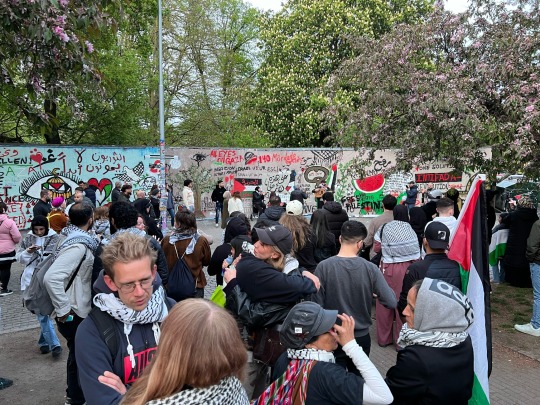
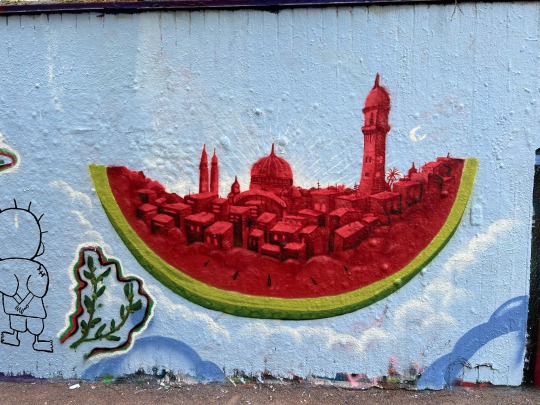
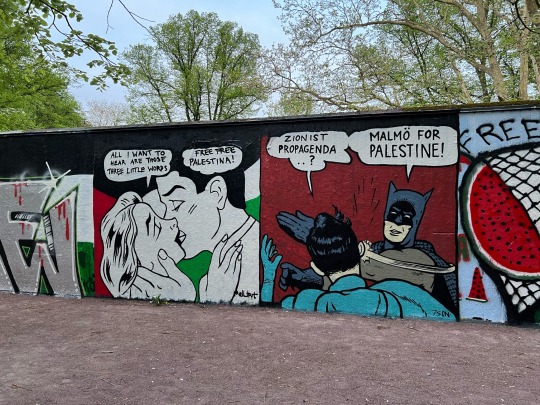
Despite the neighborhood being hit hard by gentrification over the last decade, Möllan is still predominantly foreign-born Swedes and immigrants (like me, when I was here). It’s predominantly middle-eastern folks, both immigrants and refugees, including one of the largest Palestinian populations in Europe. It’s also one of the most progressive cities in Sweden, home to the leftist Vänsterpartiet and fairly active queer and antifascist groups. And all of these groups have been uniting for the protests
So as you can expect, the protests around the park and the city have been pretty constant. Entirely peaceful, to everyone’s credit, but absolutely constant. And you can’t go anywhere near the event without seeing Palestinian flags flown from windows and shopfronts in solidarity, or protest graffiti on Eurovision posters.
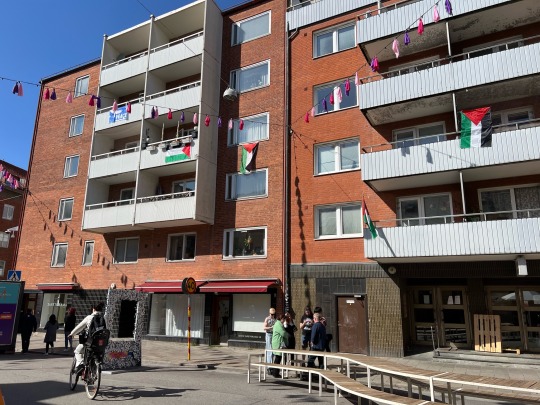

Meanwhile, the security presence around the Eurovillage has been absolutely wild. In a city where police rarely even carried pistols, there are now approximately ten times as many police, many bearing automatic rifles. When protests threaten to get too close to the park, they shut off entrances and surround protesters with police vans. Helicopters and drones buzz in the skies above, to the annoyance of locals. And local Swedes look at the armored police vehicle like an unwelcome alien from another planet (or worse, like an unwelcome trend from America).
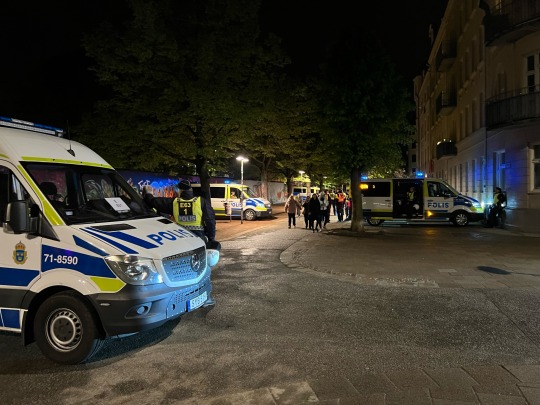
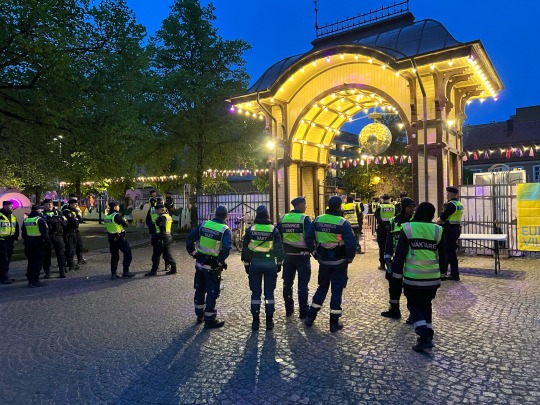
Thankfully, I haven’t seen any particular abuse out here in Malmö, although I know there have been lots of arrests at protests around the arena proper. I’m hoping it stays that way for the finals tonight.
But just know that for every picture you see of the Eurovision events, there’s countless scenes of protest from the local residents, often just on the other side of the camera.
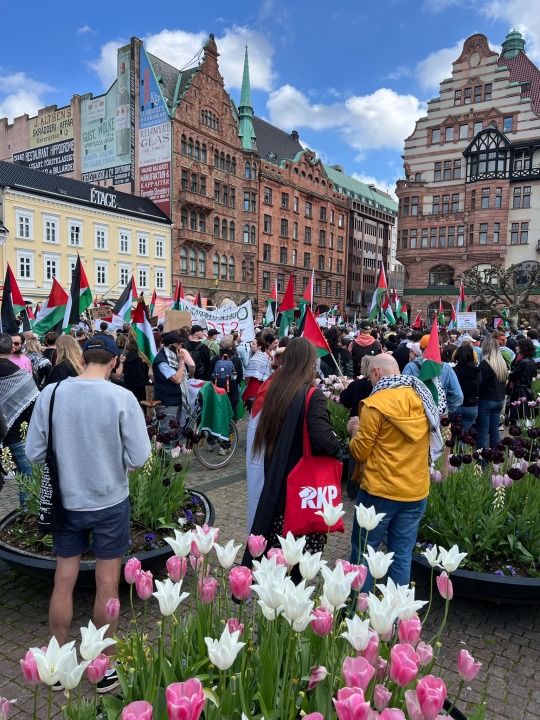
112 notes
·
View notes
Text
It marks a setback for U.S. efforts to speed up the deployment of electric heating and vehicles, and increases the number of buildings that will ultimately require costly retrofits to meet modern energy standards.
“Really bad and surprising news,” Mike Waite, the director of codes at watchdog American Council for an Energy-Efficient Economy and a volunteer who helped author this year’s commercial building codes, wrote in an email to HuffPost. “The ICC Board went against their consensus committees, appeals board and staff.”
The surprise decision to overturn the appeals board’s ruling comes after the ICC violated its own internal policies to give the industry groups extra time to file appeals. Advocates, who called the move a “scandal,” were relieved when the appeals board delivered what seemed like a final verdict. The board of directors has typically followed the appeals board’s recommendations.
42 notes
·
View notes
Text
[ 📹 Scenes of fire and destruction after Israeli fighter jets and drones targeted the Al-Jaouni Primary School in the Nuseirat Refugee Camp, in the central Gaza Strip, which housed displaced Palestinian families, resulting in the deaths of four civilians and wounding several others. ]
🇮🇱⚔️🇵🇸 🚀🏘️💥🚑 🚨
DAY 224: MASSACRES CONTINUE IN GAZA, COLONISTS CONTINUE ATTACKING HUMANITARIAN AID TRUCKS AS UNITED NATIONS WARNS OF IMMINENT FAMINE
On 224th day of the Israeli occupation's ongoing special genocide operation in the Gaza Strip, the Israeli occupation forces (IOF) committed a total of 4 new massacres of Palestinian families, resulting in the deaths of more than 31 Palestinian civilians, mostly women and children, while at least another 56 others were wounded over the previous 24-hours.
It should be noted that as a result of the constant Israeli bombardment of Gaza's healthcare system, infrastructure, residential and commercial buildings, local paramedic and civil defense crews are unable to recover countless hundreds, even thousands of victims who remain trapped under the rubble, or who's bodies remain strewn across the streets of Gaza.
This leaves the official death toll vastly undercounted, as Gaza's healthcare officials are unable to accurately tally those killed and maimed in this genocide, which must be kept in mind when considering the scale of the mass murder.
In a continuation of the Israeli occupation's ongoing genocide, Israeli settlers burned a Palestinian truck and attacked its driver east of Ramallah, in the occupied West Bank.
According to local reporting, a group of Israeli colonial settlers intercepted a Palestinian truck they thought was heading to Gaza, in the vicinity of the illegal Kochav Hashahar settlement, located on 1948 Palestinian lands in the central occupied West Bank, before attacking the driver and setting the truck on fire.
Reporting states that the Israeli settler colonists are intent on preventing the passage of humanitarian aid to the Gaza Strip.
On Wednesday, settlers blocked a total of 26 commercial trucks from passing from the occupied West Bank to Gaza, while attacks on Palestinians, along with their homes, vehicles, lands and properties, have escalated in recent days.
Over the last week, Israeli colonists expanded their attacks, and have targeted humanitarian aid trucks on several occasions, burning and looting the aid trucks and attacking their drivers, while also preventing vehicles from passing to the Gaza Strip.
At the same time, the Israeli occupation forces (IOF) have continued their closure of the Rafah and Karm Abu Salem border crossings, beginning on May 7th, where the vast majority of humanitarian aid has, until now, entered the enclave.
In other news, the first aid trucks are waiting in the Gaza Valley for approval from the Israeli occupation authorities so they begin to approach the Gaza floating port built by the Americans.
US Central Command said trucks loaded with humanitarian aid began moving towards the beach on Friday morning through the floating dock, however the amount of aid is not expected to be sufficient for the needs of over 2 million Palestinians displaced across Gaza.
Meanwhile, the United Nations Emergency Relief Coordinator, Martin Griffiths, warned on Friday of the risk of imminent famine for the Palestinian population of the Gaza Strip.
Griffiths warned that “there are almost no food stocks left in the southern Gaza Strip," while stressing that the Gaza Strip is in "imminent danger" of famine, and that bringing fuel into the enclave was "almost impossible."
Griffiths added that humanitarian operations in Gaza have been "stuck and cannot be planned," since the start of the Israeli occupation forces' operations in Rafah.
As the situation becomes more dire, and as the occupation army continued their attacks and bombardment of Rafah, the United Nations Relief and Works Agency for Palestinian Refugees (UNRWA) announced today that more than 630'000 Palestinians have been displaced from the Rafah area.
Speaking on the social media platform X, UNRWA wrote that "since the military offensive on Rafah started 6 May, over 630,000 people have been forced to flee the area."
With the majority of the population displaced, many Palestinians have sought refuge in the heavily damaged city of Deir al-Balah, in the central Gaza Strip, which UNRWA described as "unbearably overcrowded with dire conditions."
In the meantime, the Israeli occupation army continued its attacks on various axis of the Gaza Strip, slaughtering civilians by the dozen and further destroying what little remains of Gaza's homes, businesses and infrastructure.
Israeli artillery shelling also continues in the neighborhoods of eastern and central Rafah, in the south of Gaza, as Israeli Merkava tanks and armored personnel carriers have been stationed in the vicinity of the Eastern Cemetery and the Al-Salam neighborhood, while occupation fighter jets bombed the home of the former Mayor of Rafah, Issa Al-Nashar, as well as the home of Nasr Fahjan.
At the same time, IOF warplanes bombed a gathering of civilians on the Al-Awda roundabout in central Rafah, while a civilian house in the Al-Geneina neighborhood, east of Rafah, was also targeted in a bombing.
In yet another war crime, occupation aircraft raided the area surrounding the Kuwait Specialized Hospital, also in Rafah, shattering the hospital's windows, damaging two ambulances, and wounding at least 5 healthcare workers.
Yet another violent raid targeting the Hamad family home, near the Zaroub roundabout, resulted in a number of casualties, while a series of raids on neighborhoods southeast of Khan Yunis led to the deaths of at least 9 Palestinian civilians.
In another tragedy, four members of the Kawarea family were murdered when their home near the European Gaza Hospital, in the Al-Fukhari neighborhood of Khan Yunis, was bombed by Israeli warplanes.
Meanwhile, in the central Gaza Strip, IOF air forces bombed the Al-Jaouni School housing displaced Palestinian families, in the Nuseirat Refugee Camp, killing four Palestinians and wounding large numbers of civilians.
Intense artillery shelling also hammered the area north of the Nuseirat Camp and also pummeled the village of Al-Mughraqa, also in central Gaza.
The bombardment and shelling continued north of Gaza as well, where at least 8 civilians were murdered following an Israeli bombing on the Al-Hoja area of the Jabalia Camp.
In yet another horrific atrocity, Zionist warplanes bombed a Palestinian house in Jabalia al-Balad, after which, local civil defense crews managed to recover the bodies of 6 martyrs, while three more civilians were killed in a strike on the Al-Faluja neighborhood of the Jabalia Camp.
Similarly, Israeli artillery detatchments fired dozens of shells into the Al-Qasaib neighborhood, along with the Al-Tawam and Al-Saftawi neighborhoods of Jabalia.
Another occupation airstrike targeted a residential home in the Al-Shati Refugee Camp, west of Gaza City, while occupation raids also targeted downtown Gaza City.
As a result of the Israeli occupation's ongoing special genocide operation in the Gaza Strip, the death toll among the local population has risen to exceed 35'303 Palestinians killed, including in excess of 15'000 Palestinian children and over 10'000 women, while another 79'261 others have been wounded since the start of the current round of Zionist aggression, beginning with the events of October 7th, 2023.
May 17th, 2024.
#source1
#source2
#source3
#source4
#source5
#source6
#source7
#source8
#videosource
@WorkerSolidarityNews
#gaza#gaza strip#gaza news#war in gaza#gaza genocide#genocide in gaza#israeli genocide#genocide#genocide of palestinians#israeli occupation#israel#israeli war crimes#war crimes#crimes against humanity#palestine#palestine news#palestinians#free palestine#israel palestine conflict#gaza conflict#middle east#politics#news#geopolitics#world news#global news#international news#war#breaking news#current events
23 notes
·
View notes
Text
Ko-fi prompt from @thisarenotarealblog:
There's a street near me that has eight car dealerships all on the same lot- i counted. it mystifies me that even one gets enough sales to keep going- but 8?? is there something you can tell me that demystifies this aspect of capitalism for me?
I had a few theories going in, but had to do some research. Here is my primary hypothesis, and then I'll run through what they mean and whether research agrees with me:
Sales make up only part of a dealership's income, so whether or not the dealership sells much is secondary to other factors.
Dealerships are put near each other for similar reasons to grouping clothing stores in a mall or restaurants on a single street.
Zoning laws impact where a car dealership can exist.
Let's start with how revenue works for a car dealership, as you mentioned 'that even one gets enough sales to keep going' is confusing. For this, I'm going to be using the Sharpsheets finance example, this NYU spreadsheet, and this Motor1 article.
This example notes that the profit margin (i.e. the percentage of revenue that comes out after paying all salaries, rent, supply, etc) for a car dealership is comparatively low, which is confirmed by the NYC sheet. The gross profit margin (that is to say, profits on the car sale before salaries, rent, taxes) is under 15% in both sources, which is significantly lower than, say, the 50% or so that one sees in apparel or cable tv.
Cars are expensive to purchase, and can't be sold for much more than you did purchase them. However, a low gross profit margin on an item that costs tens of thousands of dollars is still a hefty chunk of cash. 15% gross profit of a $20,000 car is still $3,000 profit. On top of that, the dealership will charge fees, sell warranties, and offer upgrades. They may also have paid deals to advertise or push certain brands of tire, maintenance fluids, and of course, banks that offer auto loans. So if a dealership sells one car a day, well, that's still several thousand dollars coming in, which is enough to pay the salaries of most of the employees. According to the Motor1 article, "the average gross profit per new vehicle sits at $6,244" in early 2022.
There is also a much less volatile, if also much smaller, source of revenue in attaching a repairs and checkup service to a dealership. If the location offers repairs (either under warranty or at a 'discounted' rate compared to a local, non-dealership mechanic), state inspections, and software updates, that's a recurring source of revenue from customers that aren't interested in purchasing a car more than once a decade.
This also all varies based on whether it's a brand location, used vs new, luxury vs standards, and so on.
I was mistaken as to how large a part of the revenue is the repairs and services section, but the income for a single dealership, on average, does work out math-wise. Hypothesis disproven, but we've learned something, and confirmed that income across the field does seem to be holding steady.
I'm going to handle the zoning and consolidation together, since they overlap:
Consolidation is a pretty easy one: this is a tactic called clustering. The expectation is that if you're going to, say, a Honda dealership to look at a midsize sedan, and there's a Nissan right next door, and a Ford across the street, and a Honda right around the corner, you might as well hit up the others to see if they have better deals. This tactic works for some businesses but not others. In the case of auto dealerships, the marketing advantage of clustering mixes with the restrictions of zoning laws.
Zoning laws vary by state, county, and township. Auto dealerships can generally only be opened on commercially zoned property.
I am going to use an area I have been to as an example/case study.
This pdf is a set of zoning regulations for Suffolk County, New York, published 2018, reviewing land use in the county during 2016. I'm going to paste in the map of the Town of Huntington, page 62, a region I worked in sporadically a few years ago, and know mostly for its mall and cutesy town center.

Those red sections are Commercially Zoned areas, and they largely follow some large stroads, most notably Jericho Turnpike (the horizontal line halfway down) and Walt Whitman Road (the vertical line on the left). The bulge where they intersect is Walt Whitman Mall, and the big red chunk in the bottom left is... mostly parking. That central strip, Jericho Turnpike, and its intersection with Walt Whitman... looks like this:

All those red spots are auto dealerships, one after another.
So zoning laws indicate that a dealership (and many other types of commercial properties) can only exist in that little red strip on the land use map, and dealerships take up a lot of space. Not only do they need places to put all of the cars they are selling, but they also need places to park all their customers and employees.
This is where we get into the issue of parking minimums. There is a recent video from Climate Town, with a guest spot by NotJustBikes. If you want to know more about this aspect of zoning law, I'd recommend watching this video and the one linked in the description.
Suffolk county does not have parking minimums. Those are decided on a town or village level. In this case, this means we are looking at the code set for the town of Huntington. (I was originally looking on the county level, and then cut the knot by just asking my real estate agent mom if she knew where I could find minimum parking regulations. She said to look up e360 by town, and lo and behold! There they are.)
(There is also this arcgis map, which shows that they are all within the C6 subset of commercial districting, the General Business District.)
Furniture or appliance store, machinery or new auto sales
- 1 per 500 square feet of gross floor area
Used auto sales, boat sales, commercial nurseries selling at retail
- 5 spaces for each use (to be specifically designated for customer parking)
- Plus 1 for each 5,000 square feet of lot area
This is a bit odd, at first glance, as the requirements are actually much lower than that of other businesses, like drive-in restaurants (1 per 35 sqft) or department stores (1 per 200 sqft). I could not find confirmation on whether the 'gross floor area' of the dealership included only indoor spaces or also the parking lot space allotted to the objects for sale, but I think we can assume that any parking spaces used by merchandise do not qualify as part of the minimum. Some dealerships can have up to 20,000 gross sqft, so those would require 40 parking spaces reserved solely for customers and employees. Smaller dealerships would naturally need less. One dealership in this area is currently offering 65 cars of varying makes and models; some may be held inside the building, but most will be on the lot, and the number may go higher in other seasons. If we assume they need 30 parking spaces for customers and employees, and can have up to 70 cars in the lot itself, they are likely to have 100 parking spaces total.
That's a lot of parking.

Other businesses that require that kind of parking requirement are generally seeing much higher visitation. Consider this wider section of the map:

The other buildings with comparative parking are a grocery store (Lidl) and a post office (can get some pretty high visitation in the holiday season, but also just at random).
Compare them, then, to the "old town" section of the same town.
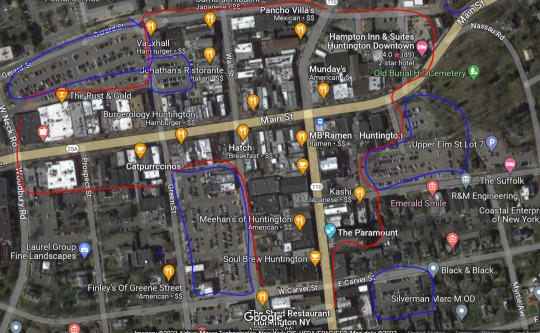
There are a handful of public parking areas nearby (lined in blue), whereas the bulk of the businesses are put together along this set of streets. While there is a lot of foot traffic and vehicle passage, which is appealing for almost any business, opening a car dealership in this area would require not only buying a building, but also the buildings surrounding it. You would need to bulldoze them for the necessary parking, which would be prohibitively expensive due to the cost of local real estate... and would probably get shot down in the application process by city planners and town councils and so on. Much easier to just buy land over in the strip where everyone's got giant parking lots and you can just add a few extra cramped lanes for the merchandise.
Car dealerships also tend to be very brightly lit, which hits a lot of NIMBY sore spots. It's much easier to go to sleep if you aren't right next to a glaring floodlight at a car dealership, so it's best if we just shove them all away from expensive residential, which means towards the loud stroads, which means... all along these two major roads/highways.
And if they're all limited to a narrow type of zoning already, they might as well take advantage of cluster marketing and just all set up shop near each other in hopes of stealing one of the other's customers.
As consumers, it's also better for us, because if we want to try out a few different cars from a few different brands, it's pretty easy to just go one building down to try out the Hyundai and see if it's better than a Chevy in the same price group.
(Prompt me on ko-fi!)
#economics prompts#marketing#zoning laws#ko fi prompts#ko fi#auto industry#automotive dealerships#car dealerships#phoenix posts
110 notes
·
View notes
Text
Over the 7 Seas
Ch.19

Charles Leclerc x Reader
The boys end up ordering fried chicken to refuel during the break. You call Charles over to join the haphazard circle on the floor. The members of SKZ do their best to welcome him to this niche little family, and discuss the subtleties and specificity of each other’s occupations. “Wow, you are a racer?! What car do you drive?”
“Actually, I am a driver for Ferrari”
Collective gasps. Everyone knows what Ferrari’s are and how big of a deal they are. “So do you drive a Ferrari around the track?”
“No actually. All of us F1 drivers get motor vehicles put together, somewhat personalized. The car is much, much smaller than a normal, commercial vehicle. It only seats one person, and we need to follow lots of weight protocols and barely drink water…” Charles goes into the many specifics of being an F1 driver. The members tell him that maybe, sometime during his stay, he can join them in the gym and show them what his routine is (of course Changbin asked that). Then, the subject switches to the music production process and how each of the members got to where they were currently.
When the food arrives, you turn to Charles. “I swear to every god there is, this Korean fried chicken will forever change your life. You will never look at fried chicken the same after this. Are you prepared?”
Stricken by your sudden change in behavior, he agrees. Everyone watches with a bated breath as he takes a bite out of his first piece. The moment the chicken makes a delicious crunch and reaches Charles’ tastebuds, his eyes widen and he almost moans. Putain de merde (Holy shit).
If this was fried chicken, what the hell had he been eating when he got KFC all these years? KFC?? Kentucky Fried Chicken? Fuck that. KFC as in Korean Fried Chicken was by all means superior.
Once he gets over the shock to his taste buds, Charles tells the three people who he learned were the main producers of the group, 3racha, about his ideas and compositions, inquiring about whether or not they could help. “Of course man! What do you need? Han here is a genius lyricist, as is Changbin, but he and I mainly produce the actual music”, says Chan. “Tell you what. Why don’t you come join us in my studio tomorrow and we can experiment with some of the stuff you have”.
Charles checks-in with you quickly, then agrees.
…
When you finally arrive at the hotel, you block out your surroundings and immediately get into the shower, feeling icky with sweat. Charles however, takes a step inside and notices that there was only one bed. Uh oh. This felt too much like one of those disgusting Hallmark movie plots. When you come out of the shower, drying your hair with a towel and in a bathrobe, you finally see the problem. “Ummm, je peux prendre le canapé (Um, I can take the sofa)”, volunteers Charles, scratching the back of his neck and trying to keep down the blush crawling up his cheeks.
“Non, non, ce n'est pas la peine de faire ça. Ce serait vraiment mauvais pour ton dos... C'est bon, je suis d'accord pour partager le lit…(No, no, no need to do that. It would be really bad for your back... It's ok, I'm ok with sharing the bed…)”
Charles just hmms in acknowledgement and rushes off to take a shower of his own.
…
When he returns, you’ve already blow-dried your hair and are sitting at the vanity doing some skincare. From your peripheral, you see that he’s only got a towel around his waist, held by an arm, and is drying his hair with a smaller towel. Quickly, you avert your eyes and continue to do your skincare as you hear him rustling around his suitcase and grabbing some clothes.
“What are you doing there Chéri?”, you hear Charles ask from behind you. You deduce that he’s changed by now and look up through the mirror. “Just some basic upkeep for my skin. I wasn’t born this flawless, you know?”, you flick your hair sassily.
“Hmm, but I beg to differ, love”.
Flustered by the sudden flattery, you scramble around the table, knocking over some of the products, and desperately trying to find your moisturizer. When you look back up through the mirror, Charles is smirking at you successfully. You grab a small hand-towel on the table and throw it at him, aiming for his stupidly handsome, dimpled face, but of course, his quick driver reflexes kick-in and he catches it before impact.
He comes over and stands over your shoulder. “Mind if I join you?”
You turn to him and he bends down to your level. Scooping out some of your moisturizer, you rub it on his face, taking your time to trace the arch of his nose and over his cheekbones. Charles watches as you gently massage the product, his eyes never leaving the concentrated look on your face. When you’re done, you break this intimate moment by stretching your neck up slightly and leaving a light kiss at the corner of his lips.
#smut#formula 1#f1#kpop#fluff#f1 x reader#charles leclerc#charles leclerc x reader#skz#skz imagines#stray kids#jyp stray kids#jypartists#jyp entertainment
14 notes
·
View notes
Text
On one of my first reporting trips to Haiti, in 1987, I set out north by road from the capital, Port-au-Prince, on the eve of an election, hoping to get a taste of voter sentiment in the countryside.
After 50 miles, my car was stopped at a roadblock on the outskirts of a seaside town called Saint-Marc. There, bands of thugs loosely allied with right-wing politicians were roughing up passengers, extorting money from them, and, in at least one case, setting a vehicle on fire.
I was allowed to proceed but warned that I couldn’t return to the capital until after the election the next morning. For whatever reason, the thugs had decided they would shut down the highway for 48 hours. When my reporting was done, I headed back by the same route, and the scene had badly deteriorated. A line of stopped vehicles stretched into the distance, and now, burnt-out wrecks lay strewn on either side of the roadbed.
When my car reached the front of the line and we were interrogated, I was alarmed to find that the same man who had warned me against trying to return was still holding sway. After a long and squirmy conversation, he finally let me through, though, but not before administering several punches to the head of my terrified driver.
This was just the smallest intimation of the trouble to come. When I went out to cover voting in the capital the next day, one of the first scenes I came upon was the site of a massacre at a polling station hosted by a school. Thus commenced my introduction to Haiti.
Over the next six years, during which I made countless visits to the country, often involving lengthy stays, I sometimes imagined I had seen everything. After one violent coup d’état, armed groups occupied the airport, stopping all commercial aviation. To fly in, I banded together with other Miami-based reporters to charter a Learjet plane, but on approach to Haiti’s capital, the pilot was warned off with the threat that our plane would be shot down if it attempted to land.
The next day, we rented another small jet, and this time there was no one running or policing the airport. We landed and walked through a terminal that had mysteriously been left completely deserted.
In 1992, I was invited to the army headquarters for an interview with the leader of the right wing junta, U.S.-trained Lt. Gen. Raoul Cédras. At the appointed time, I was ushered into a conference room on the second floor of the rickety building where seven senior Haitian military officers sat stone-faced around a large table. When Cédras entered the room, our meeting began with him sliding his revolver to the middle of the table and asking his men unsmilingly who would like to volunteer to shoot this journalist who has been such a pest. After a long moment of tense silence, he took his gun back and holstered it and the interview proceeded. Haitian journalists, I hasten to add, experienced much worse.
A year later, I stayed on in the country for weeks after the start of an international embargo of a military regime that had overthrown the elected leader, the Rev. Jean-Bertrand Aristide, and was now clinging defiantly to power. One afternoon in October 1993, I looked on as a gun-waving band of a few dozen militiamen orchestrated a raucous portside demonstration that prevented the docking of a 522-foot-long U.S. warship, the USS Harlan County, with more than 200 soldiers aboard.
The ship had arrived bearing a contingent of international peacekeepers that was intended to pave the way for Aristide’s rightful restoration. The secret to their success in turning the ship back was the chant “Somalia, Somalia.” Their invocation of the Battle of Mogadishu, more famously known to Americans as the Black Hawk Down Incident, a week earlier, in which 18 Americans were killed, had more power than any magician’s spell.
I have taken the time to revisit scenes like these for one reason that is obvious and another that may not be. The first is that Haiti is presently in the grips of a very serious crisis, with no functioning government and violent gangs running rampant. The second is that, despite its catastrophic nature, few of the elements in Haiti’s grave situation are actually entirely new.
During the trying period in which I covered the country, I witnessed moments when the National Assembly completely broke down and became essentially irrelevant, when two or more people claimed legitimacy to rule, and when power briefly seemed vacant. I saw times when the streets were ruled by gangs or by shadowy militia like the Tonton Macoutes and the so-called attachés. I saw fecklessness by the international community, of which the Harlan County incident is but one example, and I also saw fleeting moments when the world appeared to come through for Haiti when every alternative seemed exhausted.
This included the restoration of Aristide to power through a U.S.-led intervention under President Bill Clinton in 1994. My coverage of Haiti and its region ended just then, but from afar I also followed Aristide’s subsequent failure and one might even say betrayal of his country as a brittle, vindictive, and—as many of his critics believe—violence-prone and even corrupt leader. His trajectory was all the more remarkable and disheartening in light of his beginnings, as a Salesian priest and devotee of progressive liberation theology.
What makes Haiti’s situation so special today is the way that all of its past failures seem to be recurring at once, in symphonic tragedy or grand mashup. There is no president (The last one, Jovenel Moïse, was murdered in 2021.). The acting prime minister, Ariel Henry, has been effectively exiled. There is no parliament. There is no army. There is barely a police force. And there is virtually no economy, save for a lucrative traffic in narcotics from South America, for which the country has long served as a wide-open trans-shipment base.
Gangs rule the streets, but they provide no structure or order, no hope for the future, and certainly no peace. The population lives at their mercy, with ordinary people terrorized and shot randomly as they seek out food or try to go about their daily business. Large numbers of people are reduced to living on the streets under shabby tarpaulins without municipal water, sewage, or electricity.
This had all led to the return of a recurrent and hard-to-resolve debate. Should the outside world intervene, and if so, what form should this take? The deployment of a Kenyan police contingent has been delayed by the effective anarchy in Port-au-Prince—as well as the Kenyan High Court decision—and for a cluster of reasons, historic and current, the United States is taking a hands-off approach, avoiding any direct intervention of its own. The historical reasons for this are solid.
Little known to most Americans, the United States has a destructive, racist, and corrupt imperial history in Haiti, which includes an intervention by the Marines in 1915, following another period of extraordinary political violence in the country. Washington’s contemporary reluctance would seem to stem from domestic U.S. politics: After a century of foreign interventions, deploying U.S. troops overseas for nation-building or even peacekeeping purposes is nowadays considered a vote loser.
Where does this leave Haiti? Sources of optimism are difficult to find. A starting point for the outside world might be a reckoning with how brutally and thoroughly Haiti was exploited in its past. This begins with the creation by France of what has often been called the most profitable colony in the world. This is a story that traces back to the early 18th century and the launching of a prison industrial labor camp system, prettified under the name “plantations,” in order to produce sugar on an untold scale.
Cane was only one of the raw ingredients. The lives of Africans who were brought there and forced to work in the fields was the other. In the human equivalent of planned obsolescence, newly enslaved Africans were worked to death with an average life expectancy of roughly five years from the time of arrival. Replacing this labor due to mortality was considered then just an ordinary feature of business. I wrote extensively about what the world owes Haiti as a result of this gruesome exploitation in my book Born in Blackness.
Crimes like these were insidiously compounded by the embargo that Western nations placed on Haiti as punishment for the audacity of winning its own freedom from outside domination and slavery in 1804. For this insult to Western wealth and power, the country was subjected to exorbitant and crippling indemnity payments that lasted for decades.
Ultimately, though, it is in Haiti’s feat of self-liberation that the country’s hopes for rebirth must lie. Modern history offers few if any more triumphal stories than the defeat of one Western army after another (France, Spain, Britain, and then France again) by Africans brought to Hispaniola to be worked to death—all in the cause of freedom and sovereignty.
In 1804, when Haiti was born, no other Western nation had legally enacted the values of the Enlightenment so fully—by abolishing slavery and discrimination on the basis of race. Long before the American Civil War and major civil rights legislation of the mid-20th century, Haitians had written these ideals into their constitution.
In recent decades, Haitians have been betrayed by the greed, pettiness, and narrow vision of their elites. But history shows us an example of the capacity of its people to rise up against the worst sorts of iniquity, and the Haitian people will somehow need to summon this capacity again. And when they tell the international community what form of assistance would be most helpful, the world should rally to their needs.
8 notes
·
View notes
Text
ON THE RUN ┊ SHINSOU HITOSHI

tags: GN reader, underground heroes (reader + shinsou), OC villains (one quirk involves shooting bullets), mutual attraction/romantic tension, dubcon kiss (<- very much reciprocated just no asking beforehand)
wc: 1.3k

Fuck fuck fuck.
The uneven pavement is harsh beneath your hefty footfalls, arms bent and swinging at your sides as you try to maintain sprinting pace. Your heart is throbbing behind your ribs, crawling steadily up your throat, anxiety vining it's way into the tissue of your lungs as your breathing sharpens. Shinsou is at your back, his carbon-alloy scarf whipping in the wind as it passes, both of you running in the same direction.
Botched. It should have been a simple reconnaissance mission — being underground heroes, discretion was your area of expertise. But not only were you apparently lacking in accurate knowledge of the villains quirks, the blueprints of the warehouse had also been outdated; the two areas you were posted at had been left vulnerable, and one shadowed movement in the groups peripheral had caused the whole plan to collapse.
Of course they'd had a fucking surveillance quirk amongst their ranks. Eyes everywhere, literally.
"Fuck!"
The toe of your boot catches against a concrete slab, uplifted from the ground by the growth of an old tree root. Something thick wraps tightly around your waist and keeps you balanced — the capture weapon — and Shinsou's hand grabs your own with haste as he forces you to keep moving. "Don't stop," he says, the words strained and breathless behind his mask, "we're almost out of their territory".
A booming sound cuts over his voice, the bass felt deep in your chest, then followed by a fast pressured gust of air barely missing the skin of your arm. Takei Goro, Villain name: Arsenal. He could fire bullets made of bone from the tips of his fingers.
Shinsou's grip remains firm and you try not to panic, willing the muscles in your thighs to carry you just a little further. The only consolation was that at present you were all on equal ground, but if a member were to rush to one of their storage units and follow in a vehicle the odds would undoubtedly be in their favour.
"Persona. We... need a... plan..." you adjust your grip to interlink your fingers, squeezing to get his attention as you weave through the streets. The initial location wasn't optimal, barely any narrow alleyways to slip into given that it was an open dock and most of the buildings had withered; but with a final turn you'd be coming into a commercial street. It's a small mercy that the place is mostly empty aside from a few strays, but they all knew better than to get involved.
Skidding to a brief halt, you are suddenly yanked into the shadows as Shinsou lumbers you behind the wall of a dumpster. He feels so much taller here, forearms braced either side of you, shielding you from view as much as he possibly can. His body is firm under the fabric and mesh of his hero suit, mouth agape as he pants, shoulders rising and falling where his chin tucks to his chest in exertion.
Heat creeps up your neck, and you almost forget where you are, or how you'd ended up there. Another shot rings out, accompanied only by frantic footsteps. They clearly knew of Persona somehow, knew of his quirk, and so they were remaining eerily silent as a precaution. "I recorded one of their vocals before they found us. The guy with the eyeballs. I can scale to the roof and lure them across the street—"
Another shot. "He stayed behind, remember?" you return the whisper, instinctively curling your hands into his shirt to keep him closer, "they'll know it's you".
The noise was nearing the entrance of the alley, you could sense it lifting the soft hair at the back of your neck, adrenaline coursing readily through your system. You needed to do something, and sooner rather than later. Think.
There were other people further down, some homeless and some aimlessly walking back from whichever bar they'd been in. Neither of your faces had been seen but Shinsou had very distinct violet hair that they'd link to Persona on sight, and it wasn't well hidden even at this distance away from the streetlamps.
Without any further forethought, you reach up to unlatch the clasp at the back of his mask, catching it as it falls loose around his neck. His expression pinches slightly in confusion, eyes frantically flickering from your actions to the head of the alleyway. It isn't until you begin tugging down the zip of your heavy duty jacket that he finally asks with urgency: "what're you doing?"
The jacket was often an addition for your winter uniform, rather than for summer. But on missions such as this one it was helpful for keeping you concealed, oversized to disguise your frame and with a large hood that hung over your face. The sleeves likely would not fit Shinsou on a regular day out of costume, never mind over all the layers he already had on, but it was better than nothing.
You flinch as another shot is fired into the air, Arsenal roaring in frustration, the baritone reverberating through the narrow space between your bodies. Given no time to explain, you roll up onto the balls of your feet to hook your jacket over his head, resting the lapels over his shoulders to hide the capture weapon.
A strangers silhouette shifts into the light and you grasp the hoods fabric, stretching it to obscure his face. "Sorry. You can hit me after this," you rasp, and before he has any chance to reply you are pulling him into a kiss.
To his credit, Shinsou adjusts easily. After a sharp inhale of surprise you feel as the tension softens, the distress waning as he melts into your touch and his weight forces you back against old brick. He tilts, slotting your lips together slowly, as if he were indulging it — as if he had all the time in the world.
Admittedly, you get a little lost in it. Something strums at your centre of gravity as he sighs into your mouth, your tongue tentatively licking into his, hips cradling hips and breaths stuttered. In the distance you hear two men speaking in low tones, an edge of frustration in their voices.
"Find them?"
"Nah, just a couple'a fuckin' kids fooling around".
The voices fade as they walk away, but you can't bring yourself to let go just yet, and Shinsou isn't stopping either. You try to rationalise it, reason that the members could still come back to check again, but it's futile. You were both still alive, you were grateful, you felt good in his arms. The soft pull of your lip between teeth, the groan building in his sternum, the hands pawing at your waist — it felt good.
Eventually he pulls away, a quiet wet sound as you separate, a string of saliva connecting your mouths bowing as it thins. You can barely see his expression but his cheeks feel warm. The moment is suspended, fragile, and you didn't want to shatter it. "I think they're gone," you whisper, "sorry again for... for springing that on you. I couldn't think of anything else".
"Huh?" he mutters, head lifting to look towards the main street. Now illuminated by the dim light, you can see just how flushed he is, dusted with pink and orange hues. "Oh".
"Oh?" you repeat, laughing at the bashfulness weaving into his features as he nervously rubs the back of his neck. "You forgot we were being pursued?"
"No! I just," he pauses to lick his bottom lip, half-lidded eyes lingering on your face in search of something, "got caught up in it. That's all".
You'd known him for years, had been partnered together on numerous other missions. Persona was level headed and thought fast on his feet, he didn't get caught up; but then again, neither did you.
At that moment, the communication device latched to your tool belt begins to blink. You weren't sure of the time but you knew it had to be long past when you'd promised to check in, and in all likelihood the police would have been notified of the gunshots.
"We should report back," you exhale. Shinsou visibly swallows, and nods.
"Yeah".
Whatever this was, it would have to wait.

286 notes
·
View notes
Text
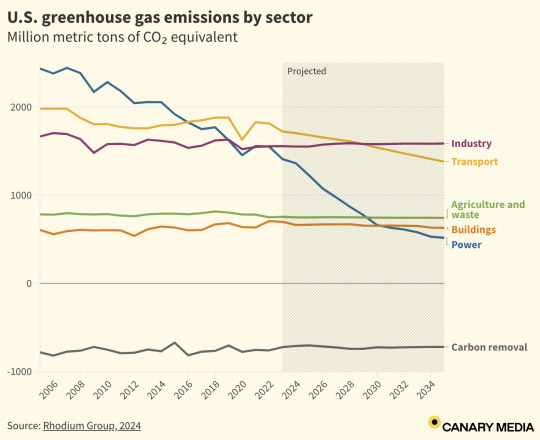

Excerpt from this story from Canary Media:
The U.S. industrial sector could claim an especially undesirable title in the coming years: It’s set to become the country’s number one source of planet-warming pollution.
The designation currently belongs to the U.S. transportation sector. Heavy industry overtook electricity as the second-highest emitter in 2023. But whereas battery-powered vehicles and renewable energy projects are proliferating nationwide, and starting to edge out fossil fuels, the nation’s factories are making only plodding progress toward slashing greenhouse gas emissions, a new report says.
On Thursday, the research firm Rhodium Group released its latest decarbonization outlook for industrial activities, including chemical refining, food processing, oil and gas production, steelmaking, and cement manufacturing.
It estimated that, under current policies, industrial emissions could decline by just 5 to 10 percent by 2040, with a reduction of 81 million to 132 million metric tons of net greenhouse gas emissions.
“It’s not nothing — but it’s also not putting us on a path toward deep decarbonization of that sector by any stretch of the imagination,” said Ben King, the report’s lead author and an associate director with Rhodium Group’s energy and climate practice.
Even those modest reductions are far from guaranteed. If companies don’t act soon to begin curbing emissions, then the sector’s total footprint could increase by as much as 12 percent from 2022 levels over the next decade, the report said.
Recently, the Biden administration has ramped up federal support for industrial decarbonization, primarily using funding from the Inflation Reduction Act and Bipartisan Infrastructure Law. In March, the U.S. Department of Energy (DOE) announced $6 billion in awards for commercial demonstration projects that can sharply reduce emissions from steel, aluminum, cement, and other areas. Another $135 million in federal awards are geared at boosting energy efficiency and curbing carbon emissions from industrial operations.
3 notes
·
View notes
Text

Part of an article from a J's Tipo on homologation specials. This section specifically on the TA64 GrpB rally special. I had to go over the translation a few times but think pretty accurate now.
CELICA GT-TS
Run hard on the dirt with a twin cam turbo!
Celica was introduced in 1982 as Japan's first specialty car equipped with a twin-cam turbo engine.
The Celica 1800GT/T made its commercial debut. The installed engine, the 3T-GTE re-engine, is based on its model name.
As you can see, it is a power unit based on the 2T/G engine, which is highly regarded as a masterpiece of the 1.6L. Specifically, the total displacement was increased to 1770cc by extending the stroke by 8mm, and a turbocharger made in-house by Toyota was installed. As a result, the 1.8L class at that time
Unprecedented maximum output of 160PS/6000rpm、21.08kgm/4800rpm.
The bore of this high-performance engine has been enlarged by 0.5 mm, and the total displacement has been increased to 1791cc to create a special unit 4T-GTEU.
The limited production car equipped with 4T-GTEU engine is the Celica GT-TS (hereinafter referred to as GT-TS).
GT-TS is a special machine for WRC participation, and the engine installed on it, 4T-GTEU, is completely exhaustive.
Volume is 21cc more than 3T-GTEU
at 1791cc. This is because of the turbo coefficient due to regulation!
When multiplied by 1.4, the total displacement is 2507cc.
This is a measure to set it in the 2.5 to 3.0L class.
3T-GTEU・If you multiply it by 1.4, you get 2478cc, which becomes the next level lower class 2.0~2.50L Therefore, 0.
The total displacement was increased by enlarging the bore by 5mm. The result is 2507cc when multiplied by the turbo factor, and if physically possible, the displacement could be up to 3L in terms of regulation.
Expansion was allowed.
GT-TS was the WRC standard at the time.
This is a machine built to meet Group B regulations. As a result, only 200 units were produced, most of which were sold in Japan. GT-TS is just a base machine,
Displacement, rear suspension
(changed to 4 Link Rigid), and other than the vehicle weight, it is no different from GT-T.
Nothing will change.
PIC CAPTION
Unlike the 240RS, this one was also sold in Japan, so the seats are firm and the cockpit looks like a production car.
5 notes
·
View notes
Photo
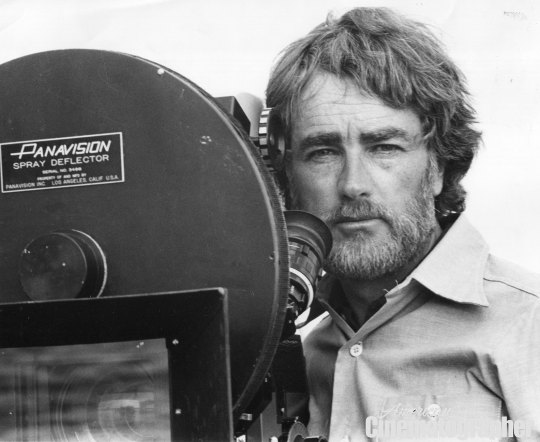
“I hear you’re making a movie about a fish,” the cinematographer Bill Butler said to the young director Steven Spielberg when they bumped into each other on the Universal lot in 1974. Butler, then in his early 50s, had already shot two projects for Spielberg – the TV movie Something Evil (1972) and Savage (1973), a pilot that was not taken up as a series. But it was their collaboration on the “fish movie” that cemented their reputations.
Summer was not previously regarded as an optimum time to release a big studio picture, which is why Jaws (1975), which flooded screens across the US rather than trickling out in stages, is considered the first summer blockbuster – though its finesse and skill, not to mention an intimate second half in which the cast dwindles to three men and a largely unseen shark, give it little in common with the sort of crash-bang-wallop productions that followed in its wake.
It remains one of the finest slow-burning suspense movies outside Hitchcock in his heyday, due in no small part to the cinematography by Butler, who has died aged 101. The production was besieged with difficulties but in 2003 Spielberg called him “the calm before, during and after every storm on the set of Jaws”.
Butler shot about 90% of the ocean scenes with a handheld Panaflex camera for greater flexibility and immediacy. Borrowing a trick he had picked up while shooting second unit on the thriller Deliverance (1972), he also made a transparent box into which the camera was placed to allow for shooting at water level. The effect, he explained, was dramatic and instantaneous. “The big advantage is that psychologically you’re asking: ‘What’s right below the water? Is that shark right there?’” Shots of the thrashing legs of oblivious swimmers “made the audience think: ‘That must look good to a shark. It looks like dinner time.’”
Jaws was one of two best picture Oscar nominees that year in which Butler had a hand, the other being Miloš Forman’s One Flew Over the Cuckoo’s Nest, the eventual winner, based on Ken Kesey’s novel about patients in a psychiatric hospital. Butler was Oscar-nominated for Forman’s film along with Haskell Wexler, who had shot the lion’s share of the footage before being sacked. It was a stormy set, with the actor Jack Nicholson refusing to speak to the director and communicating instead with Wexler and then Butler, who reportedly shot everything from the climactic party scene onwards. A year earlier he had replaced Wexler on Francis Ford Coppola’s brooding surveillance thriller The Conversation (1974).
After Jaws, Butler’s biggest commercial successes were the musical Grease (1978) as well as three consecutive sequels to Sylvester Stallone’s 1976 boxing drama Rocky, beginning with Rocky II (1979). Butler brought a special vitality to the fight scenes in the series, occasionally shooting with as many as eight cameras simultaneously. “As carefully as we planned, there were times when we expected to pan left and something unexpected happened, and we needed to go to the right or zoom instead,” he said. “When an actor slipped, we caught the expression of surprise on his face.”
Some projects even he couldn’t save. Can’t Stop the Music (1980), a vehicle for the disco group the Village People, was a flop that later acquired a cult following. That honour eluded another musical, Graffiti Bridge (1990), starring and directed by Prince. It was shot by Butler, once again serving as an 11th-hour replacement, at the singer’s Paisley Park studios near Minneapolis.
Butler was born in Cripple Creek, Colorado, to Wilmer, a farmer, and Verca, a psychiatric nurse. The family moved to Henry county, Georgia, when he was five, then on to Mount Pleasant, Iowa. He was educated at Mount Pleasant high school and received a degree in engineering from the University of Iowa, where he became fascinated with cameras. He worked for four years as a radio station engineer while also setting up a television station that was later sold to ABC.
Next he got a job at the Chicago-based WGN-TV, where he met the director William Friedkin. Their documentary The People Vs Paul Crump (1962), about an African American man on death row, was screened for Otto Kerner, the governor of Illinois, in rough-cut form the night before Crump was due to be executed. Examining the evidence presented in the film, Kerner changed the sentence to life without parole. “I remember thinking: ‘My God, film has this kind of power?’” said Butler. “That little 16mm film saved someone’s life.”
For Philip Kaufman, Butler shot Fearless Frank (1967), starring Jon Voight as a man who is killed then resurrected as a superhero crime-fighter. He collaborated for the first time with Coppola on the director’s road movie The Rain People (1969), then shot Nicholson’s directorial debut, Drive, He Said (1971).
Among his later credits are the baseball comedy-drama The Bingo Long Travelling All-Stars & Motor Kings, the rape revenge thriller Lipstick (both 1976), Demon Seed, in which Julie Christie is impregnated by a malevolent computer, the conspiracy thriller Capricorn One (both 1977), the horror sequel Damien: Omen II (1978) and two military comedies, Stripes (1981) and Biloxi Blues (1988).
Butler was lauded for his television work: he won an Emmy each for Raid on Entebbe (1976), based on a real-life hostage rescue mission in Uganda, and an adaptation of A Streetcar Named Desire (1984) starring Ann-Margret as Blanche DuBois. He was nominated for another for shooting the steamy mini-series The Thorn Birds (1983).
In 1997 he shot a pair of films that echoed his past glories: the monster movie Anaconda owed more than a little to Jaws, while Don King: Only in America, made for TV, utilised his expertise in rendering ring-craft. For the latter, Butler built a box camera that the actor Danny Johnson, who played the world heavyweight champion Larry Holmes, could physically attack. Johnson “pulverised the lens”, said the director, John Herzfeld. “He literally beat it to shit. You’re completely in a subjective point of view.”
Butler maintained that the 1970s were the “perfect time” for him to make his name. “It was a merging of a lot of film styles that up until then had been very staid, very straightforward. There were certain rules you didn’t break, except I was one of those people that came to break all the rules.”
He is survived by his second wife, Iris (nee Schwimmer), their children, Genevieve and Chelsea, and three daughters, Judy, Patricia and Pam, from his first marriage, to Alma (nee Smith), which ended in divorce in 1983.
🔔 Wilmer Cable Butler, cinematographer, born 7 April 1921; died 5 April 2023
Daily inspiration. Discover more photos at http://justforbooks.tumblr.com
25 notes
·
View notes
Text
A research group has developed a prototype calcium (Ca) metal rechargeable battery capable of 500 cycles of repeated charge-discharge -- the benchmark for practical use.
The breakthrough was reported in the journal Advanced Science on May 19, 2023.
With the use of electric vehicles and grid-scale energy storage systems on the rise, the need to explore alternatives to lithium-ion batteries (LIBs) has never been greater. One such replacement is Ca metal batteries. As the fifth most abundant element in earth's crust, calcium is widely available and inexpensive, and has higher energy density potential than LIBs. Its properties are also thought to help accelerate ion transport and diffusion in electrolytes and cathode materials, giving it an edge over other LIB-alternatives such as magnesium and zinc.
But many hurdles remain in the way of Ca metal batteries' commercial viability. The lack of an efficient electrolyte and the absence of cathode materials with sufficient Ca2+ storage capabilities have proved to be the main stumbling blocks.
Read more.
#Materials Science#Science#Rechargeable batteries#Batteries#Calcium#Copper sulfide#Tohoku University#Copper#Sulfides
18 notes
·
View notes